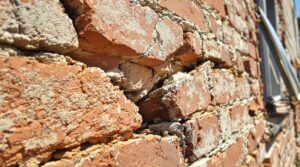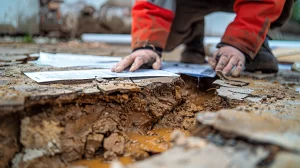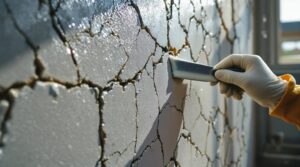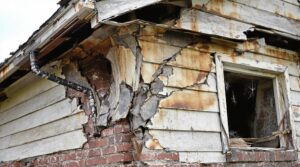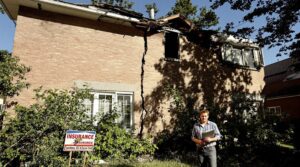Structural damage repair costs vary greatly based on severity and type, ranging from $500 for minor foundation cracks to over $50,000 for complete rebuilding. Common issues include foundation settlement, bowing walls, and water intrusion, with repair methods spanning from basic crack filling to extensive underpinning. Professional inspections, typically costing $200-$500, assess damage extent and recommend solutions. Understanding insurance coverage, contractor selection, and financing options proves essential for maneuvering these critical home repairs effectively.
Key Takeaways
- Foundation repairs range from minor crack filling ($250-$800) to major underpinning ($36,500), depending on damage severity.
- Common signs of structural damage include diagonal wall cracks, misaligned doors/windows, uneven floors, and water intrusion issues.
- Professional inspections cost $200-$500 and assess foundation type, drainage systems, and soil stability for comprehensive evaluation.
- Prevention strategies include regular monitoring, proper drainage maintenance, and moisture control to avoid costly future repairs.
- Repair costs vary by property size, foundation accessibility, damage severity, soil conditions, and local labor rates.
Common Types of Structural Damage in Homes
When homeowners encounter structural issues, they typically face five major categories of damage that can compromise their property's integrity.
Foundation cracks appear in two distinct forms: vertical cracks, which generally represent minor issues requiring basic repairs, and horizontal cracks, which signal more serious structural concerns demanding professional intervention.
Bowing walls and uneven floors indicate significant foundation settlement problems. While bowing walls necessitate immediate structural repairs ranging from $5,000 to $15,000, uneven floors can create costly gaps between walls and flooring structures.
Water intrusion presents another critical concern, potentially requiring extensive waterproofing solutions to prevent subsequent damage and mold growth.
The most severe category, structural instability, manifests through leaning walls and ceiling cracks, often stemming from significant foundation damage. Signs of foundation damage vary in severity and repair costs, with structural repairs for severe cases potentially exceeding $50,000 when substantial rebuilding becomes necessary.
Proper damage documentation through photos and detailed reports is essential when filing insurance claims for structural repairs, especially in cases involving sudden damage to the property.
Signs and Symptoms of Foundation Problems

Foundation problems manifest through specific warning signs that property owners must recognize to prevent extensive structural damage.
Interior indicators include diagonal wall cracks, misaligned doors and windows, and noticeable floor slopes that suggest underlying support issues.
External examination reveals critical symptoms such as water accumulation near the foundation perimeter and visible gaps around window frames, which signal potential foundation displacement requiring professional assessment.
Early Warning Indicators
Detecting early warning signs of structural foundation issues can prevent catastrophic damage and costly repairs to a home. Key indicators include visible cracks in walls, particularly horizontal or diagonal patterns that suggest significant foundation movement.
Uneven floors and gaps between floors and walls point to compromised structural support beneath the home. Another significant sign manifests in sticking doors and windows, which indicates foundation shifting has affected frame alignment.
Water-related issues serve as vital warning signals. Proper assessment of drainage issues is essential when water pooling occurs around the foundation perimeter.
Additionally, basement water leakage often reveals foundation cracks or inadequate waterproofing. These signs of foundation problems require prompt professional evaluation to determine the extent of damage and necessary remediation steps.
Interior Structural Red Flags
Inside residential structures, telltale signs of foundation problems manifest through distinct structural irregularities that homeowners must carefully monitor. Visible cracks, particularly horizontal or diagonal patterns in walls, indicate severe foundation instability requiring immediate professional evaluation. Sticking doors, misaligned windows, and uneven floors often reveal underlying foundation problems that compromise structural integrity.
| Warning Sign | Potential Cause | Required Action |
|---|---|---|
| Wall Cracks | Foundation Shifting | Structural Assessment |
| Door/Window Issues | Settlement Problems | Foundation Inspection |
| Floor Irregularities | Weakened Structural Supports | Support System Analysis |
Water intrusion in basements presents additional concerns, potentially leading to mold growth and further deterioration. These symptoms, combined with bouncy or squeaky floors, signal compromised support systems that demand prompt investigation to prevent escalating structural damage. Documenting these structural issues is crucial for insurance claims process and securing appropriate compensation for repairs.
Exterior Damage Assessment
External inspection of residential structures reveals distinct indicators of foundation deterioration that complement interior warning signs.
Critical indicators include visible cracks in basement walls, particularly horizontal fissures, which often signal severe foundation damage requiring immediate assessment. Water pooling around the foundation and associated poor drainage conditions can accelerate structural degradation through soil erosion and hydrostatic pressure.
Key observations should focus on gaps between the foundation and surrounding soil, as well as separation between foundation walls and siding damage.
These symptoms, combined with misaligned doors and windows, typically indicate significant foundation movement affecting structural integrity.
Professional foundation assessment becomes essential when these exterior signs manifest, as proper repair methods depend on accurate diagnosis of underlying soil conditions and the extent of structural compromise.
Documenting structural issues thoroughly helps support homeowners insurance claims when foundation damage results from covered perils.
Cost Breakdown by Damage Severity
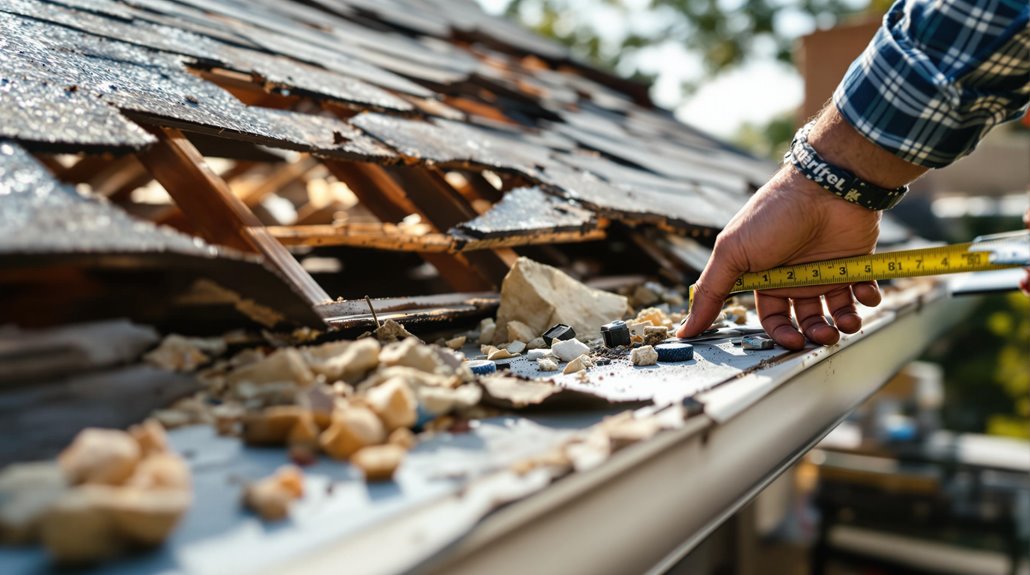
Understanding the cost implications of structural damage requires categorizing repairs into three distinct severity levels.
Minor foundation damage, typically presenting as hairline cracks, ranges from $500 to $1,500, while diagonal cracks may cost between $1,000 and $3,000. Early detection and timely repairs at this stage are vital for preventing escalation.
Moderate foundation issues represent the middle tier of structural damage, with repair costs spanning from $5,000 to $15,000. These cases often involve bowing walls and water intrusion problems, which can require specialized repair methods.
Water-related repairs specifically average between $2,000 and $10,000.
Severe foundation damage, characterized by structural instability, presents the highest cost burden. These complex cases can necessitate extensive repair methods such as piering and underpinning, typically costing $10,000 to $15,000.
In extreme scenarios requiring complete rebuilding, costs can exceed $50,000, underscoring the importance of preventive maintenance and early intervention.
Working with public adjusters can increase settlement amounts by up to 500% for non-catastrophic structural damage claims.
Professional Assessment and Inspection Details

When undertaking structural repairs, a thorough professional assessment serves as the critical first step in identifying and evaluating potential foundation issues. Qualified inspectors employ specialized equipment and systematic approaches to analyze structural damage exhaustively.
| Inspection Component | Assessment Method | Key Indicators |
|---|---|---|
| Foundation Type | Visual examination | Cracks, settling |
| Drainage Systems | Moisture detection | Water damage, pooling |
| Soil Stability | Core sampling | Composition, compression |
The inspection process typically costs between $200 and $500, providing homeowners with detailed insights into their property's structural integrity. Inspectors evaluate visible signs such as uneven floors, misaligned doors, and foundation cracks while utilizing advanced tools like laser levels and moisture meters to determine the extent of damage. Following the assessment, professionals generate extensive reports detailing necessary repairs and associated costs, enabling property owners to make informed decisions about remediation priorities and preventing further structural deterioration. A claims adjuster's assessment will be crucial for determining insurance coverage and validating repair estimates for structural damage claims.
Methods of Structural Repair and Their Costs
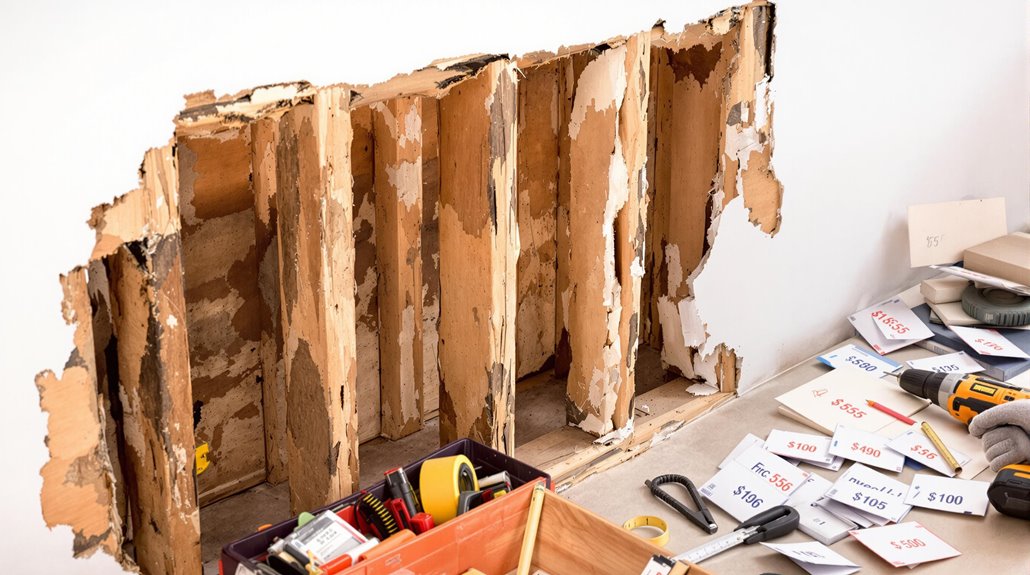
Structural repair methods vary considerably in both complexity and cost, requiring careful consideration of the damage severity and budget constraints.
Foundation repairs span from minor crack filling at a few hundred dollars to major underpinning projects reaching $36,500. The selection of repair types depends on the specific structural issues present.
Waterproofing represents a critical component of structural maintenance, with costs ranging from $2,300 to $23,000 for basement treatments. Crawl space repairs, including thorough waterproofing, average $8,250.
For bowing walls, fortress stabilization utilizing carbon fiber and Kevlar technology presents a modern solution at approximately $13,000. Foundation crack repair, essential for preventing water infiltration, typically costs between $1,400 and $4,000.
When addressing structural concerns, costs escalate proportionally with damage severity. Minor repairs may require only basic crack filling, while major structural interventions like underpinning demand substantial investment and professional expertise.
Factors That Impact Repair Expenses
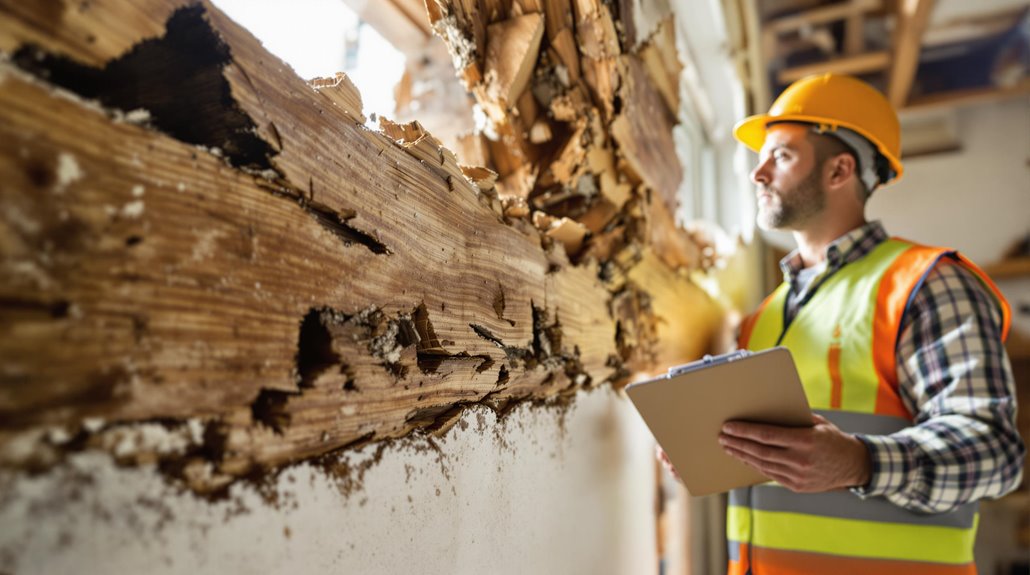
Multiple key determinants influence the total cost of home structural repairs, with property size and foundation accessibility serving as primary cost drivers.
Larger homes typically require more extensive materials and labor, substantially increasing foundation repair costs. The accessibility to the foundation can necessitate additional excavation work or structural modifications, further impacting expenses.
The severity of foundation issues directly correlates with repair complexity, ranging from minor issues costing $250-$800 to major structural problems exceeding $15,000.
Soil stability represents another vital factor, as expansive soils can necessitate more frequent interventions and enhanced reinforcement measures.
Geographic variations in labor costs and contractor expertise also play significant roles in determining final expenses.
These factors combine to create a complex pricing matrix that professionals must carefully evaluate when judging structural damage and developing thorough repair strategies.
Prevention and Maintenance Strategies
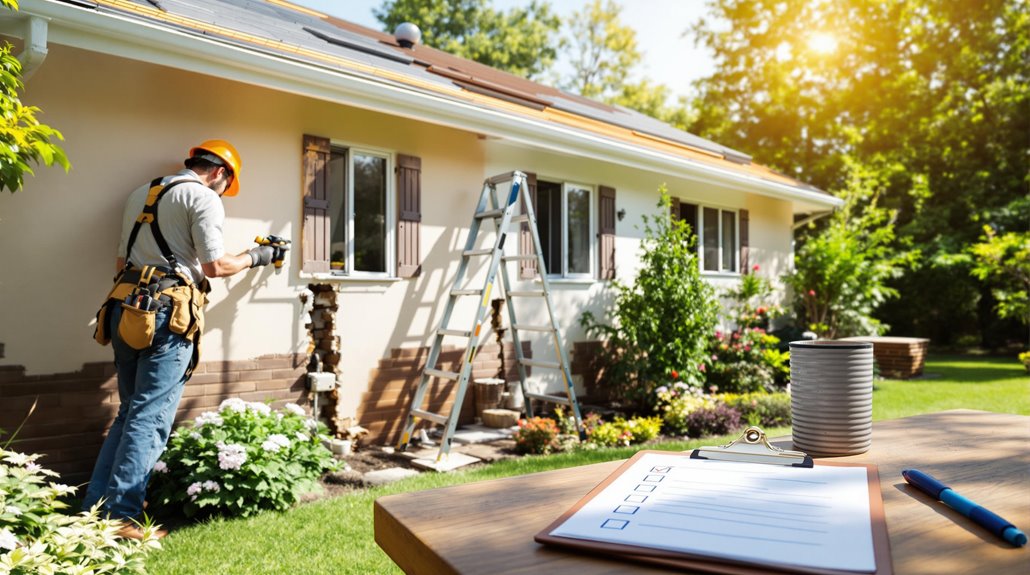
A proactive approach to home maintenance can greatly reduce the likelihood of severe structural damage and minimize long-term repair costs. Regular monitoring of foundation conditions enables homeowners to identify potential issues before they escalate into major structural problems requiring expensive foundation repair services.
Implementing effective maintenance strategies begins with proper drainage around home systems. This includes maintaining gutters, downspouts, and landscape grading to prevent water damage and protect the soil around foundation from excessive moisture.
Homeowners should monitor cracks in foundation walls and floors, addressing even minor fissures promptly to stabilize foundations before deterioration advances.
Controlling moisture levels through waterproofing techniques is essential for maintaining structural integrity. Installing sump pumps, vapor barriers, and proper ventilation in basements and crawlspaces helps regulate humidity and prevent water infiltration.
Consistent soil moisture management, particularly during extreme weather conditions, helps prevent the expansion and contraction that can compromise foundation stability.
Working with public adjusters during complex structural damage claims can help homeowners secure 30-50% higher settlement amounts for repairs.
Finding and Selecting Qualified Contractors

When undertaking significant structural repairs, selecting qualified contractors becomes a critical decision that directly impacts project success and long-term home stability.
Homeowners must carefully evaluate contractors' specialized experience in foundation work to guarantee compliance with safety standards and ideal repair outcomes.
To make informed decisions, homeowners should check credentials and licensing status of potential contractors to avoid legal issues. It's vital to request multiple quotes from different qualified professionals, allowing for cost comparison while maintaining quality standards.
Reading online reviews and testimonials provides valuable insights into contractors' track records and reliability.
Before committing to any contractor, obtain a detailed estimate that breaks down all costs, including labor, materials, and potential additional expenses.
This thorough approach helps homeowners make sound decisions while confirming necessary repairs are completed by competent professionals who understand structural intricacies and local building requirements.
Insurance Coverage and Financial Options
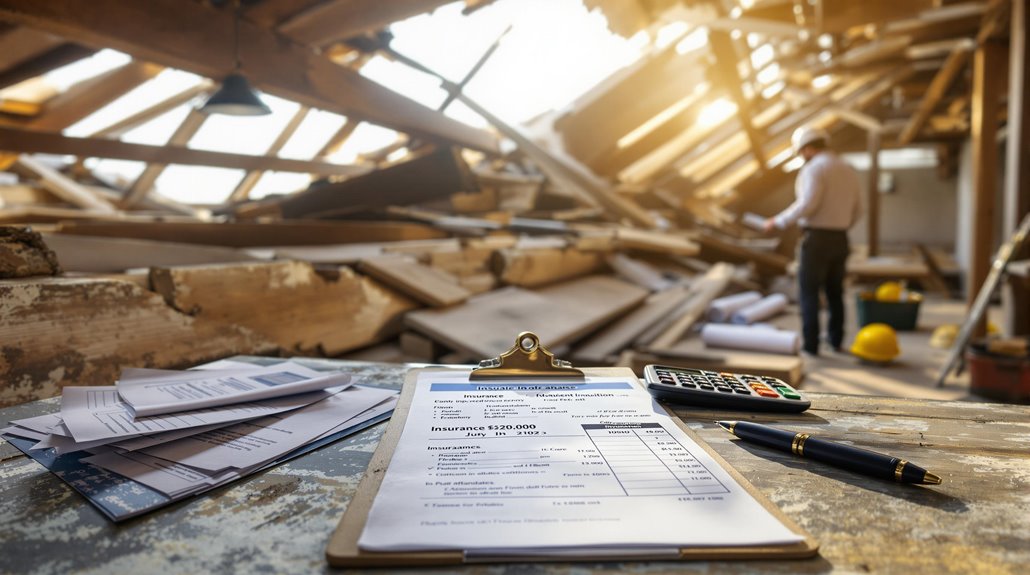
Most homeowners insurance policies provide specific coverage for sudden or accidental foundation damage while excluding gradual deterioration and maintenance-related issues.
The substantial costs of foundation repairs, which typically range from $2,000 to $15,000, necessitate careful review of policy limits and consideration of additional coverage options or endorsements.
Homeowners facing significant repair expenses can explore financing alternatives such as home equity loans or lines of credit, which generally offer more favorable interest rates than personal loans.
Understanding your policy's medical payments coverage can help protect against potential liability if someone is injured during repair work on your property.
Coverage Types and Limits
Understanding homeowners insurance coverage for structural damage requires careful examination of policy types and their associated limits. Standard policies typically protect against specific forms of structural damage, with coverage limits ranging from $100,000 to $500,000 depending on the policy terms.
Key aspects of structural damage coverage include:
- Basic coverage for damage caused by fire, storms, and vandalism
- Separate flood insurance requirements for water damage from flooding events
- Deductible payments ranging from $500 to $2,500 before coverage activation
- Optional supplemental coverage for foundation repairs in high-risk areas
Property owners should review their insurance policies carefully to understand exclusions and consider additional riders for extensive protection, particularly in regions prone to specific environmental risks such as soil movement or severe weather conditions. Working with a public adjuster can help homeowners better understand their coverage limits and maximize their claims during structural damage incidents.
Payment Plans and Financing
Homeowners facing structural repairs have multiple payment and financing options to manage repair costs effectively.
Foundation repair companies commonly offer flexible payment plans that distribute costs over time, making extensive repairs more financially manageable. While homeowners insurance may cover damage from unforeseen events, additional financing solutions are available for uncovered repairs.
Many repair services partner with financial institutions to provide specialized low-interest loans for structural improvements. Homeowners can also leverage home equity loans or lines of credit to fund necessary repairs.
Federal assistance programs, including USDA and FHA initiatives, may offer grants or favorable loan terms for eligible homeowners undertaking home improvements.
Understanding your insurance coverage limits can help determine if structural damage repairs will be fully covered under your homeowners policy.
These diverse funding options enable property owners to address critical foundation issues promptly while maintaining financial stability.
Timeline and Planning for Structural Repairs

When undertaking structural repairs on a home, establishing a detailed timeline and strategic plan is vital to guarantee successful outcomes and cost-effective solutions.
Professional inspections serve as the foundation for developing an effective repair strategy, helping identify the scope of structural damage and determining necessary interventions.
Key planning elements include:
- Extensive inspection to assess damage extent and required repairs, typically costing $250-$800 for initial evaluations
- Multiple contractor estimates to secure competitive pricing, with foundation repairs ranging from $2,000 to $7,500
- Timeline development accounting for repair complexity, ranging from days for minor fixes to several weeks for major structural work
- Regular maintenance scheduling to prevent future issues, particularly following extreme weather events
This systematic approach enables homeowners to address repairs efficiently while managing costs and preventing further deterioration.
Early detection through planned inspections remains essential for minimizing extensive structural damage and associated expenses.
Consider working with public adjusters to ensure fair settlements and maximize insurance claim payouts for covered structural repairs.
Frequently Asked Questions
How Much Does It Cost to Repair Structural Damage to a House?
Structural repair costs typically range from $2,000 to $36,500, depending on damage assessment findings. Severe foundation issues requiring extensive labor and materials can exceed $50,000, necessitating thorough structural integrity evaluation. Additionally, property owners should consider the potential for unexpected expenses during repairs, as hidden damage may not be visible until work begins. Engaging a qualified structural engineer can provide a comprehensive structural engineer cost breakdown, helping to clarify the necessary repairs and associated costs. This proactive approach not only aids in budgeting but also ensures that the root causes of structural issues are adequately addressed.
Can a House With Structural Damage Be Repaired?
Houses with structural damage can be repaired through professional assessment and appropriate repair techniques. Success depends on damage severity, chosen repair methods, and proper implementation to restore structural integrity.
How Much Does Structural Damage Affect Home Value?
Structural damage typically reduces home equity by 10-30%, impacting market appraisal and resale value. Property depreciation varies based on repair disclosure, renovation costs, and buyer perception of investment potential.
What Type of Foundation Repair Is Most Expensive?
Complete foundation replacement with extensive underpinning solutions represents the costliest repair method, typically exceeding $50,000 when addressing severe structural failures, soil stability issues, and thorough drainage system modifications.
Final Thoughts
Structural damage repair requires meticulous planning, professional assessment, and adequate financial preparation. As the adage states, "An ounce of prevention is worth a pound of cure," implementing regular maintenance protocols can greatly reduce long-term repair costs. The success of any structural repair project depends on thorough documentation, selecting qualified contractors, understanding insurance coverage parameters, and establishing an all-encompassing timeline for completion.
For homeowners dealing with structural damage claims under their homeowners insurance policy, both insurance industry insiders and legal experts strongly advise consulting a qualified state-licensed public adjuster. These professionals work exclusively for policyholders, not insurance companies, serving as dedicated advocates throughout the claims process. Public adjusters are state-licensed professionals who help navigate complex insurance policies, identify hidden damages often unknown to policyholders, thoroughly document losses, and negotiate with insurance companies to ensure fair settlements while protecting policyholder rights.
By engaging a public adjuster, homeowners can typically maximize their claim payouts, expedite the claims process, and reduce the stress of dealing with insurance companies, allowing them to focus on property restoration. Policyholders interested in discussing their property damage or loss claims can request a no-obligation free consultation with a Public Claims Adjusters Network (PCAN) member public adjuster through the contact page.

